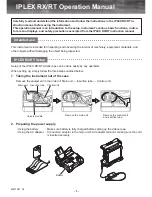
WARNING
• Make sure to avoid an electric shock when connecting the probe to the object of
measurement. Do not remove the probe from the measuring instrument after the object
of measurement is connected.
• When disconnecting the probe BNC output connector, first turn OFF the power to the
circuit under measurement. Then, disconnect the probe from the high voltage parts of the
circuit under measurement.
CAUTION
Use a soft cloth to clean the dirt. Prevent damage to the probe. Avoid immersing the probe,
using abrasive cleaners, and using chemicals contains benzene or similar solvents.
French
AVERTISSEMENT
• S’assurer d’éviter un choc électrique lors de la connexion de la sonde à l’objet de la
mesure. Ne pas retirer la sonde de l’instrument de mesure après avoir connecté l’objet
de la mesure.
• Lors de la déconnexion du connecteur de sortie BNC de la sonde, mettre d’abord HORS
tension le circuit faisant l’objet de la mesure. Puis déconnecter la sonde des parties à
haute tension du circuit faisant l’objet de la mesure.
ATTENTION
Utiliser un chiffon doux pour nettoyer la sonde. Faire attention de ne pas casser la sonde.
Ne pas immerger la sonde dans un liquide ni utiliser de nettoyants abrasifs sur la sonde. Ne
pas utiliser de benzène ni d’autres solvants sur la sonde.
Note
Accurate measurement may not be possible near objects with strong electric fields (such as
cordless equipment, transformers, or circuits with large currents).
4 Specifications
Item
Specifications
Probe length
Approx. 1.5 m
Connector type
BNC
Input resistance
10 MΩ ±2%
In conjunction with an oscilloscope with an input impedance of
1 MΩ ±1%.
Input capacitance
13.5 pF (typical)
1
In conjunction with an oscilloscope with an input impedance of
1 M
Ω ±1%.
Attenuation ratio
10:1 ±2%
In conjunction with an oscilloscope with an input impedance of
1
MΩ ±1%.
Frequency bandwidth (≤−3 dB )
DC to 200 MHz
Subject to change depending on type of oscilloscope used.
Rise time
1.75 ns max. (typical)
1
Subject to change depending on type of oscilloscope used.
Max input voltage
2
600 V (DC + ACpeak) or 424 Vrms
Operating temperature
5 to 40°C
Operating maximum relative
humidity
80% RH at a temperature of up to 31°C, decreasing linearly to
50% RH at 40°C if the temperature is 31°C or higher.
Operating altitude
3000 m or less
Storage temperature
−20 to 70°C
Storage humidity
90%RH
or less (-20 to +55°C)
45%RH
or less(+55 to +70°C)
Storage altitude
4600 m or less
Matching input capacitance
Approx. 15 to 25 pF
Safety standards
Complying standards
EN61010-031
Measurement category II
3
: 600 V (DC + ACpeak)
Pollution degree 2
4
Environmental standards
5
EU RoHS Directive compliant
1 Typical (or average) value; not guaranteed.
2 The maximum allowable input decreases depending on the frequency. Refer to the derating curve.
3 This equipment is for measurement category II (CAT II). Do not use it with measurement category III (CAT
III), nor measurement category IV (CAT IV). When using devices or accessories with different measurement
categories, the lower measurement category applies. See below for definitions of measurement categories.
Measurement Category
Definition
Measurement category “O
(Other)”
Measurement category O (Other) applies to measurement of a
circuit that is not connected directly to the main power source.
Measurement category II
(CAT II)
CAT II applies to measurement of electrical equipment that is
powered through a fixed installation such as a wall outlet wired to
a distribution board and measurement on such wiring.
Measurement category III
(CAT III)
CAT III applies to measurement at the distribution level, that is,
building wiring, fixed installations.
Measurement category IV
(CAT IV)
CAT IV applies to measurement at the primary supply level, that
is, overhead lines, cable systems.
4 Pollution degree applies to the degree of adhesion of a solid, liquid, or gas which deteriorates withstand
voltage or surface resistivity. Pollution degree 2 applies to normal indoor atmospheres (with only non-
conductive pollution).
5 For conformity to environmental regulations and/or standards other than EU, contact your nearest
YOKOGAWA office (PIM113-01Z2).
Input voltage derating
Frequency (Hz)
0.1 M
10
100
1000
600
1 M
10 M
100 M
1000 M
Max input voltage (V)
14.6V
IM 701938-01E 2/2




















